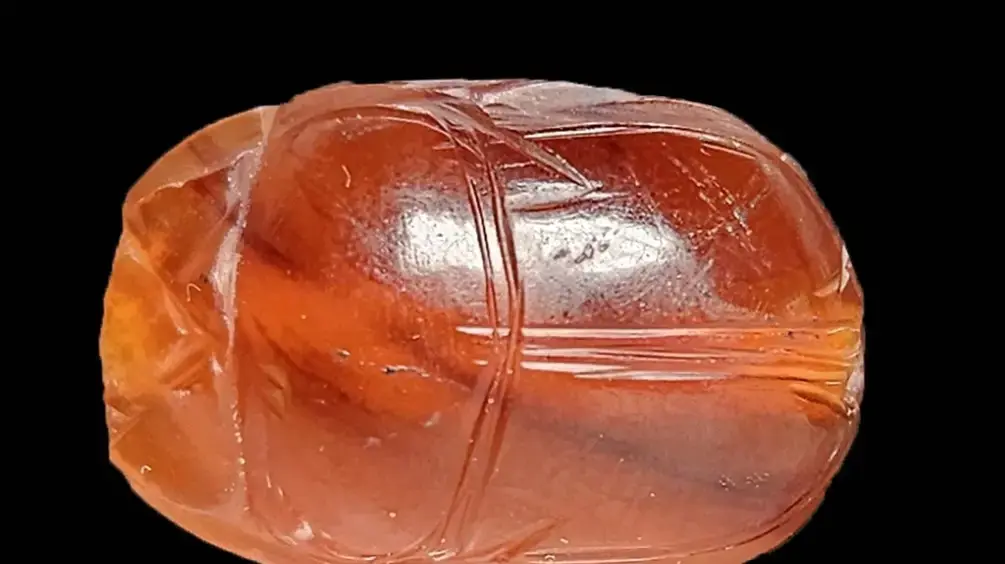Almost 3000 years old.
The Assyrian scarab amulet found in Nahal Tabor/Antiquities Authority, Anastasia Shapiro
Erez Abrahamov, a 45-year-old resident of Paduel, recently took a walk in the Nahal Tabor Nature Reserve in the Lower Galilee, and found a scarab amulet dating back to the First Temple period, about 2,800 years ago.
"I received a two-day leave from the reserves and decided to take advantage of the two sunny days for a trip," says Abrahamov.
"During the trip, I saw something shimmering in the ground. At first I thought it was a bead or an orange stone. After I picked it up, I noticed that it had engravings that resembled a beetle. I called and reported the amazing find to the Antiquities Authority."
According to Nir Distelfeld, the inspector of the robbery prevention unit at the Antiquities Authority, "I received a call from Erez, and I realized that he had found something special. I told him to take a good look at the other side - the flat side of the same scarab he found and check if there is any engraving on it. I immediately heard exclamations of admiration on the phone, and he reported to me that he recognizes a figure there."
According to Prof. Emeritus Othmer Kiel from the University of Friborg in Switzerland: "On the scarab, made of a semi-precious stone called carnelian, is depicted a griffon (mythological animal) or a winged horse at a gallop. Similar scarabs have been dated to the 8th century BC."
"During the trip I saw something shimmering in the ground."
Erez Abrahamov and the ancient amulet he found in Nahal Tabor/Antiquities Authority, courtesy of the photographer
The griffon that appears on the seal is a well-known artistic motif in the art of the Ancient Near East/Antiquities Authority, Anastasia Shapiro
"Demonstrate good citizenship"
"We thank Erez, who demonstrated good citizenship and handed over the rare scarab to the state's treasures," says Distelfeld.
"We awarded me a certificate on behalf of the Antiquities Authority for demonstrating exemplary citizenship. Such a rare find can certainly expand our knowledge of the past."
Distelfeld adds that "the beautiful scarab was found at the foot of Tel Rachsh, one of the most important mounds in the north of the country. The site is identified in the research with the city of "Anharet" (Yohshua 19:19) within the territory of the tribe of Issachar."
According to Dr. Itzik Paz, an archaeologist from the Israel Antiquities Authority who excavated at Tel Rachsh, "one of the most important remains at Tel Rech, dates from the Iron Age (6th-7th centuries BC). During this period, a large citadel stood at the top of the mound, where plastered bathing facilities, halls were found and ritual chambers, which belonged to the Assyrian rule. This rule was, as we know, responsible for the destruction of the Kingdom of Israel. The scarab that was recently discovered at the foot of Tel Rechas, may belong to the period of Assyrian rule and may indicate the presence of Assyrian (or perhaps Babylonian) officials at Tel Rechas during this period. The gryphon that appears On the seal is a well-known artistic motif in the art of the Ancient Near East, and it is common on seals from the Iron Age. In light of the paucity of finds that have been discovered, so far, within the citadel, and if the seal can indeed be dated - based on artistic aspects, to the Late Iron Age, it may be possible to link the seal For an Assyrian presence in the citadel of Tel Rachsh, which may be a discovery of great significance!"
The scarab is made of a semi-precious stone called carnelian/Antiquities Authority, Anastasia Shapiro
Nir Distelfeld, Inspector of the Robbery Prevention Unit at the Antiquities Authority, and in his hands the scarab/Antiquities Authority, Anastasia Shapiro
A type of seal common throughout the ancient world from the 4th millennium BC onwards
The scarab is a type of seal that was widely used throughout the ancient world from the 4th millennium BC onwards. The scarab seals were shaped like a dung beetle, hence their name. The name in Egyptian is derived from the verb "to be created", or "to be created", and this is because the Egyptians considered a scarab to be A symbol of the embodiment of God the Creator.
The scarabs were fashioned from a wide variety of stones, including semi-precious stones such as amethyst and carnelian, but most scarabs were made of steatite - a soft talc stone, which was usually coated with a blue-green glaze. The glaze survived only in the dry climate of Egypt, so in the scarabs discovered in Israel, It is almost impossible to find remains of glaze and the original color of the stone is mostly gray-whitish. Against this background, the orange color of the scarab stands out.
More on the same topic:
Archaeology
mascots
soldiers

